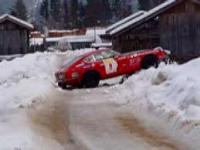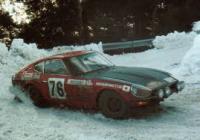Everything posted by Stanley
-
One of our members Alan Thomas is mentioned in this one:
Good Reading!
-
Getting HP out of L28
Might download the Motor vehicle code, possibly there's an exemption in there. So a CAT won't do it? Back in the 90's Ben Franklin would have solved that problem. Otherwise, any mods they can't see plus C.A.R.B. approved intake and exhaust mods are ok. Saw a late model Honda Insight last weekend that went zero to sixty in about 4 seconds - had to be an engine swap, don't think the stock 88 HP would do that. Maybe they swap the stock engine back in for emissions test.
-
Reading distributor specs and expected real world performance.
The engine pings worst when climbing a hill at full throttle and low RPM. As I recall from an old truck that had a stock vac gauge, that's also when vacuum drops. So it seems (zero experience) that you could set total advance higher with the vac can hooked to the balance tube, since it would reduce advance lugging up the hill for example. But on the other hand, acceleration might be worse. And Nissan must have had good reason to build it like they did. Wonder how that mod worked out?
-
Reading distributor specs and expected real world performance.
Nope, nothing about setting timeing for dual points in the engine manual, it's in Chilton.
-
Stumped in New Mexico
Checked the graph in the engine manual, for 7000 ft and 32F baseline is about 2.5 turns down. But at 68F it should be about 1.5 turns down, and at 86F about 1 turn down. Looked for that graph in the pdf engine manual online at xenon but it wasn't there, Don't know what year that manual is but it's in my 1972 manual.
-
Stumped in New Mexico
What rpm is giving you 30 deg advance? Do you have one on those fully degreed race type pulleys (or a dial-back timing light)? My pulley is only marked at 0,5,10,15, 20. At 7000 ft the air is thinner so you need to lean the mix so the air/fuel is correct. But when it's cold the air is denser so you need a richer mix setting. There's a graph in FSM for baseline settings. But if the needles/nozzles are worn it could be way off.
-
Reading distributor specs and expected real world performance.
That bit refers to the insanely complicated procedure for setting the dual point emissions distributor for the '73 AT's. It's in the engine manual, but I won't pretend to understand it. A car with AT will start and run much better with the single point distributor, at least mine does. If I understand, in the Spec. and Service Data table Blue posted, the 17 deg @650 and 17 deg at 700 (AT) refer to crank rpm like on the tach. But the advance characteristics in the same table refer to dist degrees and rpm that are 1/2 tach rpm. BTW the table is for the D-606-52 which is the "Euro" non-emissions dist. Now for the two graphs. The two sets of data graphed had me totally confused until I added the numbers together and divided by 2. Then you get the same start and max numbers in the Spec Table. My guess is that these tables are for mechanics testing distributors. If a distributor tests within the two lines, it's OK. With a puzzle like this, who needs Sudoku?
-
Final Drive - Done For The Season
-
Final Drive - Done For The Season
-
Squeaking on startup
My car does the same thing. Thought it was normal.
-
What have I gotten into?
According to Blue book, '73's (like mine) are valued less than '72's, which are less than 71's, and so on. Maybe because they're a little heavier, have the flat tops and more smog stuff. One the other hand, they have the N-36 intakes, and supposedly a better exhaust manifold. Mine has round-tops, easier to work on because there's so much information here about tuning them. Had to remove the snake-pit (smog equipment) because the air galley was rusted out and pouring out fumes. It looks way nicer now without it. You're going to want a FSM factory service manual, you can download it or better yet find a used one. There's also the L24 engine manual, but it only covers the engine. That hose at the right side of the engine, leading from the water inlet to a tee (one side comes from the heater) looks totally shot. It's 3/4" i.d., if you start the car (and it's as bad as it looks) water's going to spray out if it doesn't run out when you fill the radiator. Might want to drain the gas tank also before starting it. Those plug wires are way too long. Clean up the engine bay, get some new hoses and some NGK wires, and it will start to look way better and be more fun to work on. Regarding your title question, some day you'll know in great detail. But for now .... Congratulations!
-
Gasoline, emissions standards, and driving habits
So we pay more for worse gas and can't take our business elsewhere (unless we live in Blythe). If what I've read is correct, increasing octane more than required to prevent detonation will reduce performance and mileage. The homemade octane booster with acetone sounds interesting. Wanted some more information and did a web search, but found so many differing personal experience opinions, and so many theoretical opinions, that I don't know any more than before. I'm using some acetone today, fiberglassing a rusty place on the truck, it works well cleaning polyester resin off the brushes and softening old fiberglass for better adhesion of new fiberglass. I've seen it melt various plastics, but it sometimes comes in a plastic container. It evaporates super fast. Doubt if a very thinned-down mix would damage fuel pumps, etc., some say it does, some say no. I'm in the process of changing fuel hoses to lined marine grade that keeps the ethanol away from the rubber - can't change the fuel bowl/nozzles hoses though. Read that some Berryman's octane booster contains acetone, but a link to their spec sheet didn't work. Their better (higher octane possible) booster's are advertised to be for Mexico/off road only. If acetone's safe and works to reduce detonation it seems a lot cheaper than adding octane booster or race gas.
-
Gasoline, emissions standards, and driving habits
What about emissions? I know that if the ignition is retarded too much, performance suffers. To go as fast you need to be more heavy-footed. So it seems to me that if you can't get the pump gas that allows timing set where it should be, emissions also will be worse. Don't know for sure but it sounds right. If so, then there's an environmental reason for having higher octane gas available, right?
-
240Z vs. 280Z
I'm into my 240Z but would also like a roadster, a 510, a Kenmeri, a 200sx, a twin-turbo 300zx, a 2013 GTR, and that's just the Nissans. Oh yeah, a Zero, a mig 15, and a P-51. Point is, can't have everything. Old cars are individuals, depends on how you like that particular car, not just the model.
-
Gasoline, emissions standards, and driving habits
I see a bunch of different octane boosters, wonder if they're all the same. I seem to have higher compression with the '81 head I'm running. Should be ok for unleaded but I'm having to set advance to 10 deg at 1000 rpm, supposed to be 17 deg at 700 for the D-606-52, or it pings. I'd really like to see how the car runs when it's set where it's supposed to be. I might mix in some 100 octane race gas for an experiment but gas is too damn expensive as is. No way to do that on a daily basis. You'd think we'd pay less in CA for the crap gas but no, it's the most expensive in the country, except maybe Hawaii.
-
Gasoline, emissions standards, and driving habits
Here in CA we're stuck with 91 octane max, reformulated gas, ethanol, all stuff to supposedly reduce emissions. But almost everybody seems to accelerate and drive fast. With low-performance gas you have to stomp harder on the gas to go as fast as you would with better gas. So everybody does. Doesn't that equate to using more gas (and so, more emissions) with the crappy gas?
-
Low RPM miss
Have a Pertronix in the old Chevy truck. 15+ years and zero maintenance, always starts right up. Guess it's paid for itself in points, caps and rotors.
-
Low RPM miss
Just to close out this thread, should say that putting a new condenser and cleaning the contacts at condenser, cap, and rotor only improved it about 75%. When The Innova light got here I checked the dwell with it first. It was 44 degrees, supposed to be 35 to 41. Started to adjust them but they looked shot (after only 6 months, due to a bad condenser?) so I put in some new Nissan points and finally got the dwell to 36 deg. Then I cleaned off the balancer and checked the timing, it was 10 deg at 1000 rpm. (supposed to be 17 deg at 700 for the D-606-52 but use CA gas). Set it to 15 deg at 1000. It's running the best it ever has and I still haven't done a full carb adjustment since putting the new needles and nozzles. No misses or backfires in any conditions. Previously I had to shift at 4800 because it wasn't pulling after that. Now it's pulling hard to 5000 and maybe higher. So timing also had at least something to do with it. Always figured condensers didn't really do anything, now I know better.
-
Exhaust Heat in Trunk
When a local shop made and installed my 2 1/4' pipe and muffler I brought a can of white heat-cure exhaust paint, and a can of prep spray, they painted it after fabricating it, before they installed it. Black (non-insulating type) lets heat in or out, white keeps it in or out. Polished chrome or other shiny metal finish would be better than white. I painted it mostly to prevent rust. The color probably makes only about 5-10% difference with heat emission.
-
Sorry to be Redundent - Help
If you want a permanent FP gauge McDaniel has some nice ones, mine is 0 to 10 psi (for the SU's) but pretty sure they have some for Fuel injection. Tempered safety glass good for 250 psi, 2 1/2" face, etc. Mine cost about $60, they gave me the name of a local supplier and I ordered it through them. Hooked it up with a Tee (in my case, attached to the mech. fuel pump), to a steel braided hose with a cloth braided cover good for 3000 psi, local hose place put it together with AN fittings. Run it through the firewall grommet where the AC used to go, hooked it to the gauge with a snap-tite fitting from M-C so I can remove it in about a minute. The gauge is mounted under the glove box with a $10 clamp from autozone. Like seeing the fuel pressure when I'm driving. That way I don't buy any unnecessary fuel pumps and hopefully will have some advance warning if it gets weak or filters get plugged. Cost 60 (gauge)+50 (hose) + 20 (snap-tite) + 10(clamp) + 10 (Tee and BSPT adapter)= $150. Was going to install an electric pump but I see the mech one is putting out steady 3.8 psi to the SU's so it saved me that money.
-
Anyone care to teach me how to change a headgasket?
Sounding more like something other than the headgasket. If it wasn't run enough to open the thermostat that might keep the oil/water gunk out of the radiator. No white smoke could mean you have a good headgasket that's keeping a corroded or cracked water or oil passage in the block or head from leaking into the cylinders. Maybe it's a good thing you're doing it yourself because if you need a new block for example a shop would charge a bunch to find that out and you'd still need a new motor.
-
[2013] What did you do to/with your Z today?
What a difference a tune-up makes. Points were shot, guess my crappy old condenser killed the old ones after only 6 months. New condenser and/or cleaning the rotor and cap contacts last week made a big difference but it still wasn't right. Dwell was 44 deg. So put in some new Nissan points, set dwell to 36 deg. Timing was about 10 deg at 1000 rpm, set it to 15 at 1000 and took a drive. Huge difference. Accidentally burned some rubber, not easy with stockish motor, AT, and sticky Falkens. Way better at all speeds. Might be pinging a little on the hill, wish CA had 93 octane. Only bummer, read the manual twice, but couldn't figure how to make the digital dial-back feature on the Innovate light work. Maybe someday.
-
Euro distributor vs California gas ?
Found this on the site:http://www.classiczcars.com/forums/engine-drivetrain-s30/23991-bypassing-vacuum-advance.html The posts by J L Purcell and Carl Beck answered my question about as well as possible. Finally figured out (when I added the numbers and divided by 2) that the double curves on the vac and mech advance graphs in the manual represent allowable values for testing the distributors. It was confusing since none of the numbers coincided with the numbers on the spec sheet. Also, the manual seems to switch between degrees at the distributor and degrees at the crank whenever they feel like it. Anyway, checked it last night, my timing is (dare I say) too retarded at 22 degrees total, maybe I didn't tighten the bolt enough last time I set it. So I'll advance it a little today to get it closer to right, and do some testing on the hill, and with the stopwatch, later next week.
-
Looking to make a "square" L24 with LD28 crank...
If $5000 is you budget, and you want a daily driver with some autocross potential, it might be possible. If compression and oil pressure are ok you could do cam and a valve job, total or partial refresh of the SU's, 2.25" exhaust and turbo muffler, lower it a little and refresh the suspension, new sticky tires and brakes. And lots of tuning, but that's more time than money. You'd cream a stock Z and a lot of other cars at the light and plenty power for twisty roads.
-
Looking to make a "square" L24 with LD28 crank...
I've read somewhere, maybe Racer Brown's book but don't remember for sure, about the benefits of a "square" engine. IIRC the concept involves having a bore that is at least equal to the stroke. By that criteria, a stock 240 is already "square".






